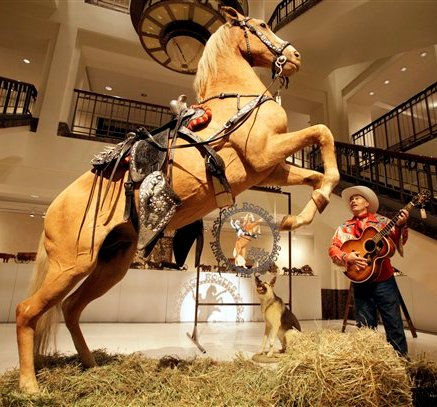 |
| Taxidermied Trigger © Horse Nation |
Then Granny Crystal died. She was a fine-looking woman with a trim figure and surprisingly perky C-cups. Grandfather started thinking about preserving his beloved. By then, technology had advanced. He considered Cryovac like the butcher uses for chickens in the market, but it was only a step up from Saran Wrap and subject to freezer burn even when double-wrapped.
About that time, Fox News ran a segment about Körperwelten, a German company that plasticizes human bodies for museums and exhibitions. Grandpa Albert got so excited, he took time out from Fox’s 134th definitive investigation into Vince Foster and asked me to google human plastination. He was disappointed to learn the cost to preserve Granny in plastic was €122 000 plus shipping and tax, even after saving $52 in freight costs by labeling her ‘non-GMO export product’.
 |
| © Körperwelten Body Worlds |
Then we found a Chinese company, Hoison Sun, which could fulfill his dream of keeping Granny forever for only $87. I expressed some skepticism about the low price, but he pointed out the vast difference between German engineering and Chinese sweatshop production.
“It’s guaranteed,” he said. “No cost of burial. No cost of cremation. Waste not, want not, I say. How could we go wrong?”
 |
| Visible Woman © Revell |
At a yard sale, we bought a huge styrofoam chest with a 7-Eleven logo on the side. We packed it with Granny and lots of dry ice. The UPS man grunted at the weight and asked with a wink if we were shipping dead bodies to China, ha-ha. I kind of tee-heed and said that would be crazy.
The German competitor required a year to plasticize bodies, so it came as a surprise a month later when our doorbell rang and the FedEx man struggled up the steps with a wooden crate from Guangzhou in the Guangdong province.
Grandfather pried off the sides with a claw hammer and then stared in awe. There stood granny in all her shimmering glory, naked right down to her muscles and bones.
Right away, we noticed one of the Chinese shortcuts. I never knew breast implants accounted for Granny’s perky boobies.
“I didn’t think they’d preserve those,” said Grandfather.
Her right rib was imprinted with the LG logo and the words “中国制造 ©李 隆丁, Tech Support call 800-867-5309.”
“Do you want to request a return RMA from tech support? She must be under warranty.”
He decided to think about it. The other problem was a sort of Tupperware-food-in-the-microwave smell, which grew more noticeable as the day warmed up. We learned the answer when Fox News reported a class action suit against the Chinese company for cutting preservation corners and a shortcoming in the curing process. Fox recommended turning the thermostat down to 58°. Grandfather decided he could live with that.
My next concern was my 12-year-old son, Bobby Jr. He invited his friends over and they stood around inspecting her perfect breasts and saying, “Wow, your great-grandmother is hot. Well, cool but hot, too.” That probably ruined the boys for life, thinking women grow implants like that.
I worry Bobby Jr may never have a love life at all. The lifelike glass eyeballs in Granny’s skull tend to rattle him.
He worked up a little bravery.
“What’s that?” he asked.
“Uh… gall bladder, I guess. Come to think of it, your grandfather has a whole lot of gall.”
“And that?”
“That’s an ovary.”
“You mean where eggs come from?”
“Right.”
“And that?”
“That would be the womb and below that is where the cervix should be.”
 |
| Brigitte and Ginger |
“So a baby’s supposed to… You mean a baby fits… How’s that possible?”
“It’s not. That’s why God makes spinal epidural blocks, anesthesia, and 1.5-litres of Southern Comfort.”
“You’re not planning to, uh, preserve Great-Grandfather Albert, are you?”
Grandpa's adage of waste-not, want-not, crossed my mind. By now, Bobby had turned greenish-grey.
“I’m not sure. He’s got ulcers, a softball-size prostate and his liver drips like a Toyota oil pan. Bobby… Bobby, are you okay?”
Thinking it would help illustrate, I dragged out the Revell Visible Man to present a male rôle model perspective, so to speak.
“See, there’s the liver, the kidneys, the pancreas and the prostate. Your great-grandfather’s is about fourteen times that size. Bobby? Bobby?”
He cracked his head against the table as he fainted. “Prostrate from the prostate,” said Grandfather unhelpfully. Fortunately surrounded by medical models, I was able to palpate his skull plates back in place and saved the expense of an ambulance to the emergency room.
Grandfather warmed Granny’s side of the bed with a hot pad and gently laid her on it. That struck me as a bit Norman Bates, but snuggling gives him comfort at night, especially under his blanket fort when he lights up her insides with a flashlight. He smells a little plasticky in the morning, so I turn the thermostat down to 58° and insist he tub soaks before coming down to breakfast.
I’m okay with Granny now. Tech support removed the silicone breast prostheses and applied extra body sealant. You can see straight through her perky boobs and from the side, they make an amazing magnifying glass. Grandfather uses them all the time when reading Sport Fisherman.
Bobby finds it extremely disturbing his friends play hacky-sack with the retired implants. Waste not, want not, I say.











































